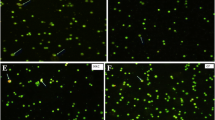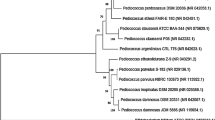Abstract
Among seven strains of lactic acid bacteria (LAB) isolated from traditional dairy products, a Lactobacillus strain was identified through 16S rRNA gene sequencing and tentatively designated as Lactobacillus brevis MK05. This strain demonstrated the highest probiotic potential through biochemical analysis, including acid and bile salt resistance, as well as antibacterial activity. The collected cell-free supernatant (CFC) of L. brevis MK05 culture, compared with MRS broth with pH equal to the pH for CFC, revealed antimicrobial activity against Escherichia coli (ATCC 25922) and Staphylococcus aureus subsp. aureus (ATCC 25923), possibly due to the presence of antibacterial metabolites other than organic acids. This strain was, therefore, selected to assess the biological activity of its partially purified secretory proteins against MCF-7 cancer cells and normal fibroblast cells via the MTT assay. The partially purified cell-secreted proteins of this strain (hereafter referred to as Lb-PPSPs) showed a time and dose-dependent anti-cancer and apoptosis induction function. There was a remarkable decline in the survival rate of MCF-7 cells at doses equal to and higher than 0.5 mg/mL after 48 h. The changes in expression of the three genes involved in the apoptosis pathway (BAX, BCL-2, and BCL2L11) in MCF-7 cells treated with the Lb-PPSPs confirm its cytotoxic activity and apoptosis induction.








Similar content being viewed by others
Data Availability
The data is defined as the minimal dataset that would be necessary to interpret, replicate, and build upon the findings reported in the article.
References
Stefanovic E, Fitzgerald G, McAuliffe O (2017) Advances in the genomics and metabolomics of dairy lactobacilli: a review. Food Microbiol 61:33–49. https://doi.org/10.1016/j.fm.2016.08.009
Shehata M, El Sohaimy S, El-Sahn MA, Youssef M (2016) Screening of isolated potential probiotic lactic acid bacteria for cholesterol lowering property and bile salt hydrolase activity. Ann Agric Sci 61(1):65–75. https://doi.org/10.1016/j.aoas.2016.03.001
Xia AN, Meng XS, Tang XJ, Zhang YZ, Lei SM, Liu YG (2021) Probiotic and related properties of a novel lactic acid bacteria strain isolated from fermented rose jam. LWT 136:110327. https://doi.org/10.1016/j.lwt.2020.110327
Kerry RG, Patra JK, Gouda S, Park Y, Shin HS, Das G (2018) Benefaction of probiotics for human health: a review. J Food Drug Anal 26(3):927–939. https://doi.org/10.1016/j.jfda.2018.01.002
Azad M, Kalam A, Sarker M, Li T, Yin J (2018) Probiotic species in the modulation of gut microbiota: an overview. Biomed Res Int 2018. https://doi.org/10.1155/2018/9478630
Van den Nieuwboer M, Van De Burgwal L, Claassen E (2016) A quantitative key-opinion-leader analysis of innovation barriers in probiotic research and development: valorisation and improving the tech transfer cycle. PharmaNutrition 4(1):9–18. https://doi.org/10.1016/j.phanu.2015.09.003
Kumar R, Dhanda S (2017) Mechanistic insight of probiotics derived anticancer pharmaceuticals: a road forward for cancer therapeutics. Nutr Cancer 69(3):375–380. https://doi.org/10.1080/01635581.2017.1267773
Bray F, Ferlay J, Soerjomataram I, Siegel RL, Torre LA, Jemal A (2018) Global cancer statistics 2018: GLOBOCAN estimates of incidence and mortality worldwide for 36 cancers in 185 countries. CA: Cancer J Clin 68(6):394–424. https://doi.org/10.3322/caac.21492
Siegel RL, Miller KD, Jemal A (2020) Cancer statistics, 2020. CA: Cancer J Clin 70(1):7–30. https://doi.org/10.3322/caac.21590
Nazir Y, Hussain SA, Abdul Hamid A, Song Y (2018) Probiotics and their potential preventive and therapeutic role for cancer high serum cholesterol and allergic and HIV diseases. Biomed Res Int, 2018. https://doi.org/10.1155/2018/342843711
Alvarez-Olmos MI, Oberhelman RA (2001) Probiotic agents and infectious diseases: a modern perspective on a traditional therapy. Clin Infect Dis 32(11):1567–1576. https://doi.org/10.1086/320518
Sharma M, Shukla G (2016) Metabiotics: one step ahead of probiotics; an insight into mechanism involved in anticancerous effect in colorectal cancer. Front Microbiol 7:1940. https://doi.org/10.3389/fmicb.2016.01940
Mendoza L (2019) Potential effect of probiotics in the treatment of breast cancer. Oncol Rev 13(2). https://doi.org/10.4081/2Foncol.2019.422
Shenderov BA (2013) Metabiotics: novel idea or natural development of probiotic conception. Microb Ecol Health Dis 24(1):20399. https://www.tandfonline.com/doi/full/10.3402/mehe/doi/full/10.3402/mehd.v24i0.20399
Nataraj BH, Ali SA, Behare PV, Yadav H (2020) Postbiotics-parabiotics: the new horizons in microbial biotherapy and functional foods. Microb Cell Fact 19(1):1–22. https://doi.org/10.1186/s12934-020-01426-w
Chuah LO, Foo HL, Loh TC, Alitheen NBM, Yeap SK, Mutalib NEA, Rahim RA, Yusoff K (2019) Postbiotic metabolites produced by Lactobacillus plantarum strains exert selective cytotoxicity effects on cancer cells. BMC Complement Altern Med 19(1):114. https://doi.org/10.1186/s12906-019-2528-2
Orlando A, Refolo M, Messa C, Amati L, Lavermicocca P, Guerra V, Russo F (2012) Antiproliferative and proapoptotic effects of viable or heat-killed Lactobacillus paracasei IMPC2. 1 and Lactobacillus rhamnosus GG in HGC-27 gastric and DLD-1 colon cell lines. Nutr Cancer 64(7):1103–1111. https://doi.org/10.1080/01635581.2012.717676
Nambiar S, Hegde V (2016) Apoptosis in cancer therapy. J med radiol pathol surg 3(5):10–14. https://doi.org/10.15713/ins.jmrps.68
Thomas CM, Versalovic J (2010) Probiotics-host communication: modulation of signaling parthways in the intestine. Gut microbes 1(3):148–163. https://doi.org/10.4161/gmic.1.3.11712
Luang-In et al. (2020) Cytotoxicity of Lactobacillus plantarum KK518 Isolated from Pak-Sian Dong (Thai Fermented Gynandropsis pentaphylla DC.) Against HepG2, MCF-7 and HeLa Cancer Cells. Pharmacogn J 12(5). https://doi.org/10.4314/tjpr.v19i11.20
Charteris W, Kelly P, Morelli L, Collins J (1998) Development and application of an in vitro methodology to determine the transit tolerance of potentially probiotic Lactobacillus and Bifidobacterium species in the upper human gastrointestinal tract. J Appl Microbiol 84 (5):759–768. https://sfamjournals.onlinelibrary.wiley.com/doi/pdfdirect/10.1046/j.1365-2.1998.00407.x
Parente E, Ricciardi A, Addario G (1994) Influence of pH on growth and bacteriocin production by Lactococcus lactis subsp. lactis 14ONWC during batch fermentation. Appl Microbiol Biotechnol 41(4):388–394. https://doi.org/10.1007/BF01982525
Mirmalek SA, Azizi MA, Jangholi E, Yadollah-Damavandi S, Javidi MA, Parsa Y, Parsa T, Salimi-Tabatabaee SA, Alizadeh-Navaei R (2015) Cytotoxic and apoptogenic effect of hypericin the bioactive component of Hypericum perforatum on the MCF-7 human breast cancer cell line. Cancer Cell Int 16(1):1–9. https://doi.org/10.1186/s12935-016-0279-4
Kumar BV, Vijayendra SVN, Reddy OVS (2015) Trends in dairy and non-dairy probiotic products-a review. J Food Sci Technol 52(10):6112–6124. https://doi.org/10.1007/s13197-015-1795-2
Fernández MF, Boris S, Barbes C (2003) Probiotic properties of human lactobacilli strains to be used in the gastrointestinal tract. J Appl Microbiol 94(3):449–455. https://doi.org/10.1080/2F01926230701320337
So SS, Wan ML, El-Nezami H (2017) Probiotics-mediated suppression of cancer. Curr Opin Oncol 29(1):62–72. https://doi.org/10.1097/CCO.0000000000000342
Sun M, Liu W, Song Y, Tuo Y, Mu G, Ma F (2020) The effects of Lactobacillus plantarum-12 crude exopolysaccharides on the cell proliferation and apoptosis of human colon cancer (HT-29) cells. Probiotics Antimicrob Proteins. 1–9 https://doi.org/10.1007/s12602-020-09699-8
Elmore S (2007) Apoptosis: a review of programmed cell death. Toxicol Pathol 35(4):495–516. https://doi.org/10.1080/2F01926230701320337
Malik SS, Saeed A, Baig M, Asif N, Masood N, Yasmin A (2018) Anticarcinogenecity of microbiota and probiotics in breast cancer. Int J Food Prop 21(1):655–666. https://doi.org/10.1080/10942912.2018.1448994
Park KB, Oh CH, Oh SH (2015) Anti-proliferative and Apoptosis Inducing Activity of Lactobacillus brevis OPK-3 Isolated from Kimchi on Leukemia Cell Lines. Current Topics in Lactic Acid Bacteria and Probiotics 3(1):1–7. https://doi.org/10.35732/ctlabp.2015.3.1.1
Z Nasiri H Montazeri N Akbari SS Mirfazli P Tarighi 2020 Synergistic cytotoxic and apoptotic effects of local probiotic Lactobacillus brevis isolated from regional dairy products in combination with tamoxifen Nutr Cancer 1–10. https://doi.org/10.1080/01635581.2020.1743871
Groussard C, Morel I, Chevanne M, Monnier M, Cillard J, Delamarche A (2000) Free radical scavenging and antioxidant effects of lactate ion: an in vitro study. J Appl Physiol 89(1):169–175. https://doi.org/10.1152/jappl.2000.89.1.169
Ouyang L, Shi Z, Zhao S, Wang FT, Zhou TT, Liu B, Bao JK (2012) Programmed cell death pathways in cancer: a review of apoptosis, autophagy and programmed necrosis. Cell Prolif 5(6):487–498. https://doi.org/10.1111/j.1365-2184.2012.00845.x
Goldar S, Khaniani MS, Derakhshan SM, Baradaran B (2015) Molecular mechanisms of apoptosis and roles in cancer development and treatment. Asian Pac J Cancer Prev 16(6):2129–2144. https://doi.org/10.7314/APJCP.2015.16.6.2129
Lopez J, Tait S (2015) Mitochondrial apoptosis: killing cancer using the enemy within. Br J Cancer 112(6):957–962. https://doi.org/10.1038/bjc.2015.85
Kadirareddy RH, Vemuri SG, Palempalli UMD (2016) Probiotic conjugated linoleic acid mediated apoptosis in breast cancer cells by down regulation of NFB. Asian Pac J Cancer Prev 17(7):3395–3403. http://journal.waocp.org/article_32528_75300b29de2566a96f39824c57150730
Author information
Authors and Affiliations
Corresponding author
Ethics declarations
Conflict of Interest
The authors declare that they have no conflict of interest.
Additional information
Publisher’s Note
Springer Nature remains neutral with regard to jurisdictional claims in published maps and institutional affiliations.
Rights and permissions
About this article
Cite this article
Pourbaferani, M., Modiri, S., Norouzy, A. et al. A Newly Characterized Potentially Probiotic Strain, Lactobacillus brevis MK05, and the Toxicity Effects of its Secretory Proteins Against MCF-7 Breast Cancer Cells. Probiotics & Antimicro. Prot. 13, 982–992 (2021). https://doi.org/10.1007/s12602-021-09766-8
Accepted:
Published:
Issue Date:
DOI: https://doi.org/10.1007/s12602-021-09766-8




